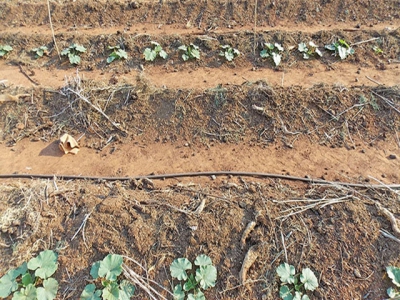Making no-till beds
When making permanent beds, a farmer should take into account tractor traffic.
 No-till vegetables: how to grow them
No-till vegetables: how to grow them No-till vegetable production is not practical for everyone and is more suited to the small-scale organic farmer.
 The role of earthworms in boosting soil quality
The role of earthworms in boosting soil quality Of all soil organisms, earthworms can be by far the largest component by weight. Their benefits are generally insufficiently appreciated by farmers.
 The value of bacteria
The value of bacteria Each group of organisms living in the soil has a different function and these organisims’ interaction with one another should create a balance that benefits
 Fungi and bacteria: the balancing act
Fungi and bacteria: the balancing act Healthy ‘living’ soil can contain up to 15t/ha of bacteria, actinomycetes, protozoa, algae, fungi, nematodes, earthworms and arthropods.
 Humus – learn to appreciate it
Humus – learn to appreciate it Chemical fertilisers came into their own after the Second World War. They were convenient to use and food production became much easier, relatively speaking.
 Cations and percentages in a soil analysis
Cations and percentages in a soil analysis If this is not the case, you can convert the amount yourself. To better illustrate the process, let’s look at an actual analysis of a soil sample from one of my
 More on controlling powdery mildew in peppers
More on controlling powdery mildew in peppers Many growers fail to recognise the disease as powdery mildew on peppers and tomatoes as the signs are different to other powdery mildew species
 Learning to live with the beet cyst nematode
Learning to live with the beet cyst nematode The cyst nematode (eelworm) get its name from the hardened cyst that it forms to protect its eggs.
 Some important green bean pests
Some important green bean pests Of the pests that damage beans, perhaps the best known is the bollworm.
 Other important fungal leaf diseases in green beans
Other important fungal leaf diseases in green beans The most well-known fungal disease in beans is rust (Uromyces phaseoli). But it has become less of a problem due mainly to the emergence of resistant bean
 Avoid bacterial diseases in green beans
Avoid bacterial diseases in green beans Bacterial diseases are a menace to all crops, because unlike the case with fungal diseases, we have few means of controlling them.
 Controlling weeds in green beans
Controlling weeds in green beans Given the high cost of labour, using chemicals is the only realistic option for weed control in most crops.
 Bean management as it affects harvesting
Bean management as it affects harvesting Harvesting is one of the big expenses in bean production and consequently needs to be done efficiently.
 What to do after planting your green beans
What to do after planting your green beans Although beans are generally a quick and easy crop to grow, problems can occur before the plant emerges.
 Preparation and planting of green beans
Preparation and planting of green beans Beans are a quick, easy crop – provided all the precautions are taken.
 Getting your green beans off to a good start
Getting your green beans off to a good start Green bean farming in South Africa has changed considerably over the past twenty years or so. Not long ago, beans were planted and weeded by hand.
 Green beans: the basics
Green beans: the basics Green and dry beans are the same species, Phaseolus vulgaris. The scarlet runner (P.coccineus) which is still popular in many countries as a home garden variety
 Sharon fruit in SA – growing local and export sales
Sharon fruit in SA – growing local and export sales Exotic Sharon fruit was introduced to South Africa in the late 1990s, but it took years to establish in which regions the trees would produce optimally

